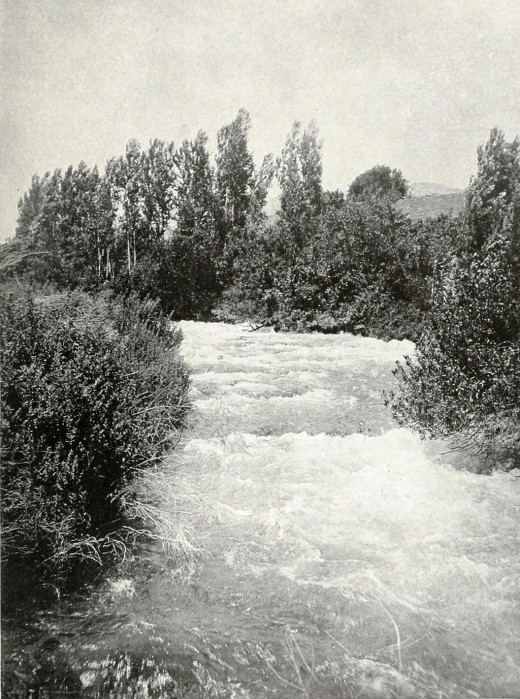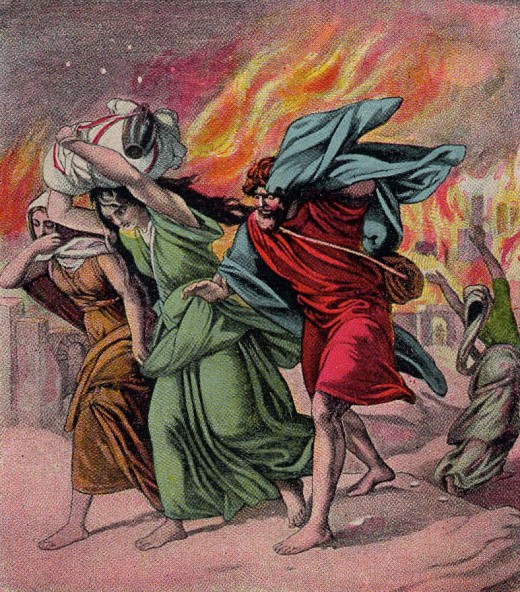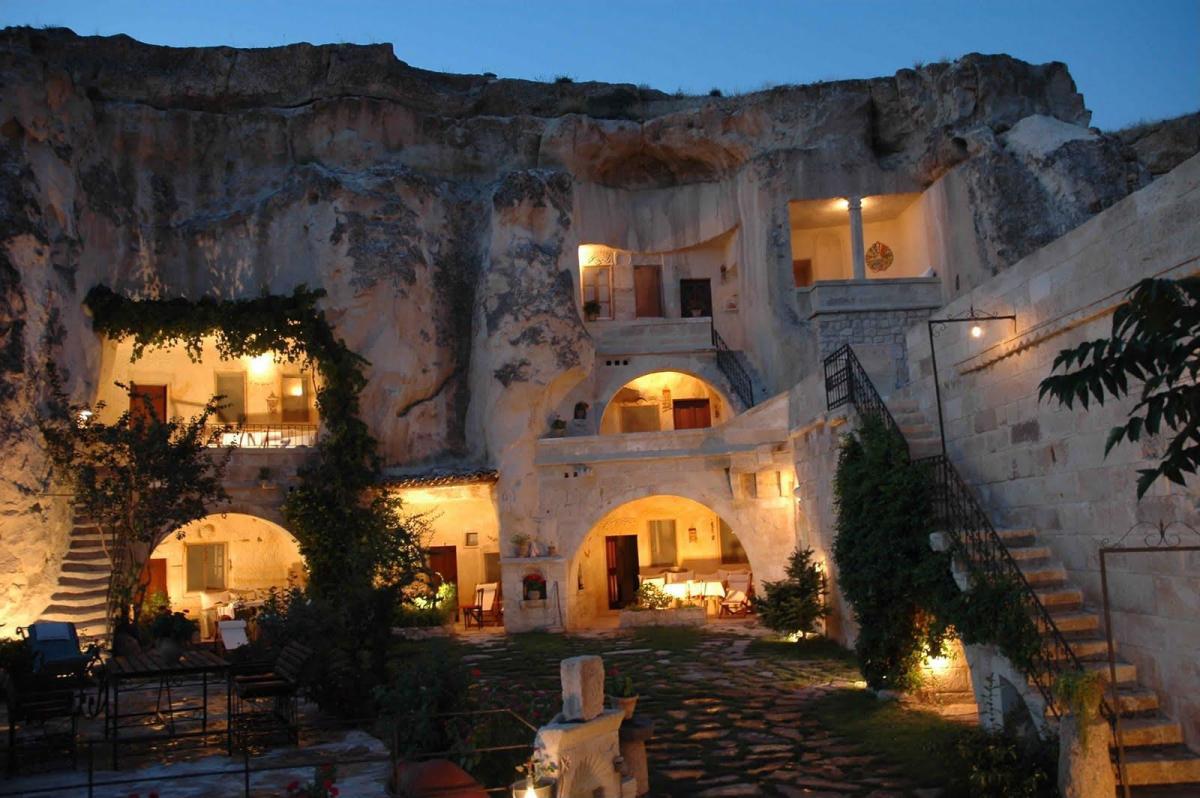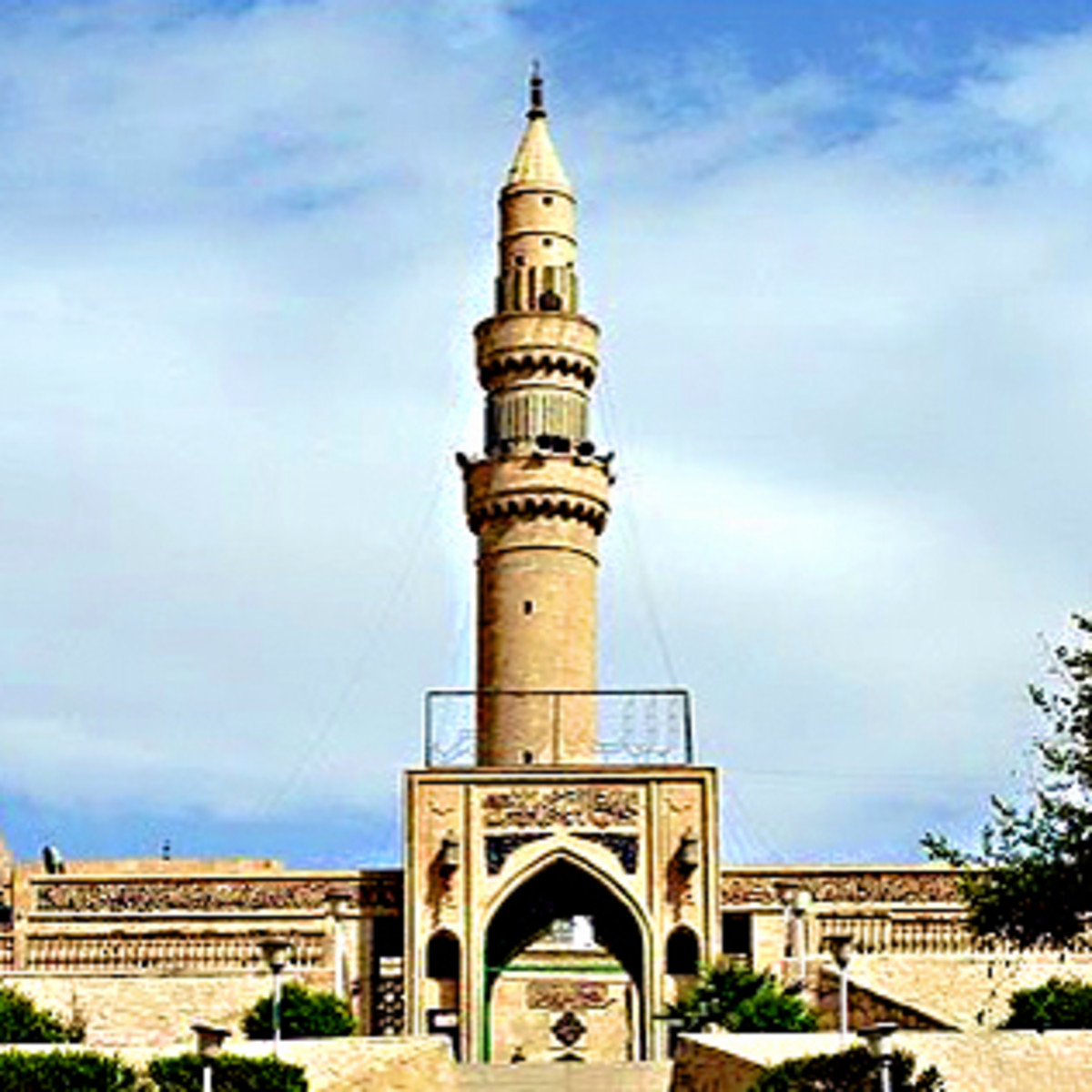Sodom and Gomorrah Revisited
Escape from Sodom

Up In Smoke
It is not infrequent in scripture for tactful elisions to hide and obscure the graphic details of sins. Certain things are assumed, others left to the imagination, which may or may not be accurate. Scriptures do not encourage us to dwell on such matters. Nevertheless, the scribe who put this riveting story into a couple of brief chapters has left us with a great deal about which to wonder. Somehow the story is paired up with the divine announcement that aged Abraham and Sarah will finally conceive. If ever there was a passage that lacked credibility, voilà. Three men visit Abraham to bring good tidings. Then two men, described as angels, visit Lot, his nephew. Lot lives in Sodom, apart from Abraham. What is he doing? Well, apparently he is minding his own business. It has to do with livestock and commerce, in order to provide for his family, including two daughters. The situation darkens as the men of Sodom, according to the accepted version, crowd round. They demand the visitors come out and yield to their pleasure. This happens after Abraham implores "the Lord" to save Sodom for the sake of the righteous who live within its walls. The three men have already told him that sin-laced Sodom will be utterly destroyed. Nevertheless, the "Lord" agrees to Abraham's logic.
As Chapter 18 turns into 19, however, it becomes clear that, besides Lot and his family, who will be saved, there is not a single righteous living human being in Sodom. Less than twenty chapters into the first book of the Old Testament, it is evident that the wording is truly early ancient. The New Testament, from the first century AD, is stylistically much different. One can be sure, nonetheless, that the story has been analyzed and retold countless times by diverse scholars. Today, some think the whereabouts of the two infamous cities have been discovered; some think they know where to look; and some think that they are as fake as the Garden of Eden and many another place described in an old, old book not meant to be taken literally. I happen to think that Sodom and Gomorrah existed, and were, in fact, destroyed in an abysmal fashion. But like many of my peers, living in the age of science, I am uncomfortable with the notion that evil (which I also do not doubt) precipitated such an apocalyptic rainstorm of fire and brimstone.
The Movie 1962
Archeology to the Rescue (?)
Unquestionably, many ancient cities were, at some point, destroyed. In the western United States, there are cliff dwellings that were mysteriously abandoned. Of course, the latter came about much later, across a wide, oceanic expanse. But clues are not always left behind. Even if they are, they must be interpreted. There are several books that address the most FAQ's about Sodom and Gomorrah, then drift off in various directions, finding safer terra firma. One author rules out the idea of Sodom, and sister city Gomorrah, lying underneath the Dead Sea. That was where an American-led expedition sought their locations in the mid-19th century. Another author speculates on the idea of Sodom having been somewhere in the Hashemite Kingdom of Jordan. Both books are good reads. It is hard to believe or disbelieve what must have once been common knowledge. As one of the aforementioned authors points out, several messianic prophets harp on Sodom. So does Jesus, in Matthew: Nevertheless I say to you that it shall be more tolerable for the land of Sodom in the day of judgment, than for you. (11:24) Thus, Jesus expresses a profound disappointment that miracles and marvels made no impact upon Capernaum.
Probably not irrelevant, archeologists have managed to prove that there was a volcanic explosion around 1700 BC, leaving behind a layer of ash in the earth. Writing, hieroglyphics, and cuneiform are not the only prime material. A geologist suggests that an earthquake over 7.0 on the Richter Scale might have been the culprit. Feel free to add burning sulphur and tar into the picture. Both are credible. One could do worse than to engage in archeological explorations in the Middle East. It is actually quite fascinating. There is no end to what can be found. What went on in Sodom, and, if in fact there was a cataclysm, can only be guessed at. But archeologists have increased the odds in favor of many destructive events not only recorded in the bible but by Plato as well. Writers in either ancient Greece or the Middle East were familiar with the time's oral history, in addition to other writings, that have since perished. Piecing together histories involving kings and peoples is, regrettably, impossible without some degree of speculation, and a healthy margin of error. We just do not know.
Jordan River

Salt and Sand
Perhaps a major reason the Dead Sea has attracted so much attention from archeologists searching for Sodom and Gomorrah is the simple fact that it contains an enormous amount of salt. The Dead Sea is also below sea level with no southern outlet. That the Jordan Valley is below sea level is unique. Its condition 4,000 years ago is, however, more pertinent. Lot's wife, so the story goes, looked back and turned into a pillar of salt. Obviously, we are dealing in addition to so much else with mythology. It contains a common theme: the warning not to look back. It crops up in the myth of Orpheus and Eurydice leaving Hades, too. Evidence of Orpheus's reputation as a musician goes back to the 6th century BC. Some believe that he was not a fictitious person, though his biographies cannot be otherwise.
As one reads up on the various hypotheticals, certain items fall into place, others do not. Egypt appears to be the most dominant country in the region. Far away, separated by the Red Sea, it was by no means isolated. It was aware of the goings-on, skirmishes, struggles, and life styles of the north. Its low tech ways -- spies, probably -- kept it informed. Trade routes were also crucial. They made it possible to exchange goods, make acquisitions, and sell products -- if one lived in the vicinity, or had the means to travel. There is discord, too. All the time, in fact. It is not infrequent to find that those who resided in cities viewed their counterparts, who dwelt, pretty much, in the sand, with contempt. Thousands of years later, it turns out that nomads still exist. They adapted. They never quit.
Dead Sea Salt

Nature and Immorality
If Sodom and Gomorrah were destroyed by means of fire and brimstone raining down from heaven, they were subjected to some kind of natural phenomenon, or, if one can utilitze the imagination, an unusual attack. An area close by, the Vale of Siddim (Genesis 14), was known for having slime pits. In the 2nd century AD, the Dead Sea was also called the Asphalt Sea. Temperatures could rise. Still, exact coordinates are matters of dispute. The city toward which survivors sought refuge was named Zoar. It is, like Sodom and Gomorrah, near the Dead Sea, located further south. But what about the charge of immorality that made Sodom and Gomorrah stand out as appreciably worse than its neighbors? Homosexuality? Seems a bit lame. It could not have been geographically confined to so small a region. How flagrant and unbridled it had become may indicate something else. But there again, paganism has traditionally been coupled with immorality. It helped to distinguish the Abrahamic tribes from others. The refusal to accept Lot's daughters in lieu of the male visitors? Not especially noteworthy. If nothing else, women were necessary regardless of sexual preference.
Chapter 19 is somewhat incoherent and much is missing. Today, one can deduce how anti-Americanism is coupled with the perception of a culture that accommodates what scripture explicitly condemns. The abhorrence of certain freedoms in Democracies causes fanatics to redress similar "wrongs" with stoning, beheadings, and other primitive methods, erroneously regarded as emblematic of righteousness. The Free World strongly disagrees. Is this truly Muslim purity? or a systematic, contagious corruption of one of the world's great religions? Nevertheless, the two tainted cities may actually have outperformed for a time the entire region in terms of everything negative. Theoretically, they have no descendants. Yet the militants, distant cousins, of basically the same terrain, now threaten greater destruction than ever before. Where before there were thousands of heartless sinners in a world whose total population reached only into the millions, now there are millions among billions whose only thought is to kill in the name of Allah. What exactly did Sodom and Gomorrah do? Genesis is imprecise. The story itself was not written until at least a thousand years after the fact.
Genesis Chapter 19

The Ancient World's Lost and Found
Depending upon what historical timetable one latches onto, a "bus", so to speak, might arrive five hundred years too early or the same amount of time late. One book speaks of Abraham and Lot in 1900 BC. Another puts them in between 2500 and 2000 BC. An interesting study plausibly claims that the legend of Sodom (not quite prepared to admit its reality) is mixed up with the city of Mashkan-shapir. The latter's remains lie in Iraq, at least a full eighteen miles away from the Euphrates, which used to run right through it. It had a ziggurat to worship the above as well as an underground network of corridors in which Satan might have been invoked. Whatever the case, Egypt's neater historical timetable, consisting of one dynasty after another, century after century, along with radiocarbon-dated funerary items, had several competitors, Mashkan-shapir perhaps being but one of them.
I wish I could recommend a single book that leaves all others in the dust, but it does not exist. Turning back to the bible, all that the reader is asked to understand is that God is not, was not, impressed by man's progress and civilization. It was not just idols. If a society crossed His redline, that was that. Then, too, Abraham was, if not an eyewitness, a contemporary. He would probably have seen the whole ordeal as punishment, too, long before it had been committed to writing. Other events are clearer, such as the change from Bronze to Iron in the 1500s BC. Egyptologists and Middle Eastern scholars of various descriptions can delve into greater detail. In the 1200s BC, Joshua and his army of Hebrews conquered Jericho, and a string of other strongholds as well. The caretakers of the promised land next to the Mediterranean flourished. Canaan, to the north, possibly the east, had already unshackled itself from Egyptian oppression. Israel was not the only beneficiary of the fading aura of an ancient power -- also, so it can be argued, having become another object of divine wrath.
Jordan Valley









